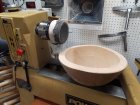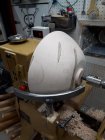I've got some large pieces of ambrosia maple that I rough turned about 22 months ago. It is good and dry. I have about a dozen pieces. I've finished turned 5 of these bowls so far. I begin by doing the outside first, of course. I use a Stronghold chuck with a wooden jamb chuck that has an old sanding mat glued to it. 2 of the 5 bowls that I have done so far, I could never get the outside to ever run perfectly true. Cut after cut, these two bowls would stay out of round. One of them, I finally got it close enough not to cause a problem and it turned out to be a decent bowl. The one that I worked on tonight would never run true no matter what. I could measure it out of round by a 1/16. I would cut a 1/16 off and it would still be that much or more out of round, time after time. I just gave up on it. My chuck was plenty tight and I had a ton of pressure on the bowl with the tailstock. I even measured my spindle rounout with an indicator and it was barely over .0001". I attached a picture of my jam chuck and a rough turned bowl that I have not started on yet.
Am I doing anything wrong or is it just some times that a piece of wood won't cooperate? I've turned a lot of big bowls and it is only this ambrosia maple that has given me this trouble. Thanks

Am I doing anything wrong or is it just some times that a piece of wood won't cooperate? I've turned a lot of big bowls and it is only this ambrosia maple that has given me this trouble. Thanks


